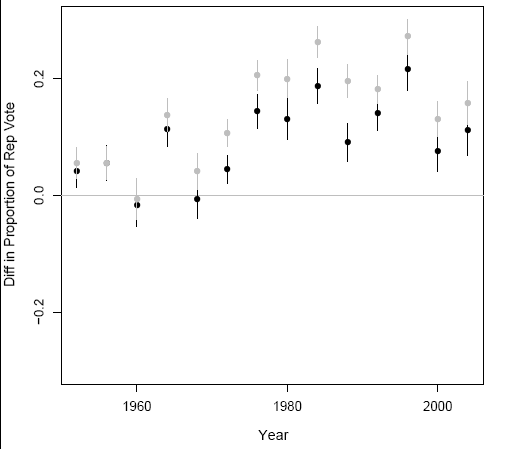A colleague asks,
How do you deal with the following from Alan Abramowitz and Ruy Teixeira’s Brookings paper:
Indeed, just how far the Democrat party fell in the white working class’ eyes over this time period can be seen by comparing the average white working class (whites without a four year college degree) vote for the Democrats in 1960-64 (55 percent) to their average vote for the Democrats in 1968-72 (35 percent). That’s a drop of 20 points. The Democrats were the party of the white working class no longer…… Al Gore….lost white working class voters in the 2000 election by 17 points. And the next Democratic presidential candidate, John Kerry, did even worse, losing these voters by a whopping 23 points in 2004. One could reasonably ascribe the worsening deficit for Democrats in 2004 to the role of national security and terrorism after 9/11 but the very sizeable 2000 deficit cannot be explained on that basis. Apparently, the successes of the Clinton years, which included a strong economy that delivered solid real wage growth for the first time since 1973, did not succeed in restoring the historic bond between the white working class and the Democrats.
My reply: When you slice things by income, you see a clear pattern of Republicans doing better among the rich of all races (except maybe Asians, but I don’t particularly trust those numbers what with small sample size):

Compared to earlier years, Democrats have lost among less well-educated voters and gained among the more educated voters, but their income profile hasn’t changed so much. As E.J. Dionne has noted, the Democrats’ strength among well educated voters is strongest among those with household incomes below $75,000–“the incomes of teachers, social workers, nurses, and skilled technicians, not of Hollywood stars, bestselling authors, or television producers, let alone corporate executives.”
So a quick answer is that I don’t necessarily see a machinist, say, as having more street-cred than a social worker with a graduate degree who makes the same amount of money. As Larry Bartels has pointed out, it’s not so easy to identify exactly what is meant by “working class.” There have been changes, but remember that the difference in voting between rich and poor has been as large in the past 10 years as it’s ever been; see page 47 of the red-blue book. Yes, it’s different rich and poor people than before, but it’s still there. It’s a mistake to think there was a past golden era of class-based voting. Geographic factors were important in voting decades ago, and they are now as well.
See here for my earlier comments on the Teixeira and Abramowitz article.
Finally, David Park made this graph of the trend since the 1950s of the rich-poor voting gap (the difference between Republican vote share among the upper third of income, minus the Republican vote share among the lower third) in Presidential elections. The gray dots represent all voters, the black dots represent whites only (yes, I know, they should be white dots…).

The rich-poor voting gap among whites has in recent elections been a bit below its 1970s-1990s peak, but it’s far from zero. And, what with increasing diversity in the minority population, it’s not so clear that “whites” is as useful a category as it once was.
P.S. More here.
'Working class' being defined as not having a four-year college degree means a heck of a different thing now than in the 1970's. There's been thirty years of an increasing proportion of people getting those degrees.